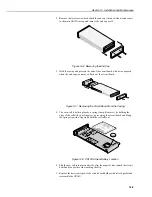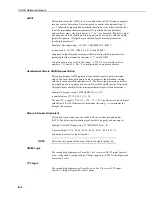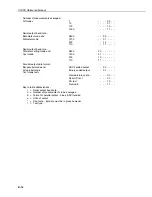
CR10X Reference Manual
B-4
ASCII
This option causes the CR10X to receive and decode an ASCII string of numbers
into one or more data values. Data is assumed to consist of an optional sign (‘+’
or ‘-’) followed by digits and an optional decimal point. Any other character that
is not the termination character (parameter 7) is assumed to be a delimiter
between data values. Any digits before a ‘+’ or ‘-’ are discarded. The data is input
assuming one start bit, eight data bits, no parity and one stop bit, with the eighth
(parity) bit ignored. All eight bits are checked for the terminator character
specified in parameter 7.
Example: The input string ‘-123.456,+1000,0000,2333,.0001*’
is converted to -123.456, 1000.0, 0.0, 2333.0 and 0.0001
and placed in input locations starting at the location specified in parameter 10
(assuming that the termination character is ‘*’, or ASCII 42).
Scientific notation is not valid. The string ‘+1.23E-12’ is converted into two
numbers: 1.23 and -12.0. The ‘E’ is interpreted as a data point delimiter.
Hexadecimal Pairs in ASCII Representation
This option decodes ASCII representation of hexadecimal code into decimal
values. The value from each pair is stored in a separate input location, starting
with the location specified in parameter 10. The data is input assuming one start
bit, eight data bits, no parity and one stop bit, with the eighth (parity) bit ignored.
All eight bits are checked for the terminator character specified in parameter 7.
Example: The input string ‘7F7E0A0B0C1E<cr><lf>’
is translated into 127, 126, 10, 11, 12, 30.
The pair ‘7F’ is equal to 7*16+15 = 112 + 15 = 127. Any character with a decimal
value below 48 (ASCII character 0) terminates the string. <cr> terminates the
string in this example.
Binary to Decimal Equivalent
This option receives and converts each 8-bit byte to its decimal equivalent
(0-255). The data is input assuming eight data bits, no parity and one stop bit.
Example: The ASCII input string ‘7F7E0A0B0C1E<cr><lf>’
is translated into 55, 70, 55, 69, 48, 65, 48, 66, 48, 67, 49, 69, 13, 10
and stored in successive input locations.
This is the only option that does not discard the eighth (parity) bit.
RS232 Logic
The second digit of parameter 2 must be 1 or 3 to receive RS232 input. Logical 1
is low voltage and 0 is high voltage. Voltage input to the CR10X control ports can
not exceed 5 volts.
TTL Logic
The second digit of parameter 2 must be set to 0 or 2 to receive TTL input.
Logical 1 is high voltage and 0 is low voltage.
NOTE
















































